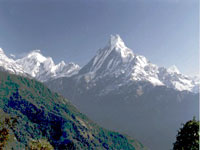
While most people save up for a week or two of adventure, some people are lucky enough to head out on a grand adventure around the world. RTW travel can free you up for a year to explore many places. Here is a brief Top 5 list of top Round the World experiences from G Adventures traveller Steve Clifford...
There were many highlights on my 10-month RTW journey but here are five memorable experiences from the Atlantic, England, Jordan, Syria and Nepal that I highly recommend to savour.
#5 Cross an Ocean by Ship — In the past most great adventures began from the deck of a ship and I was determined, at least once in my life, to unfasten my seat belt, look beyond my upright seat tray and cross an ocean at sea level. I was the only passenger aboard a small container ship sailing from Charleston, SC to Felixstowe, England, an 8-day crossing. In reality life aboard a working ship quickly becomes routine, especially if you're the only one not working. However the countless hours spent scanning the empty horizon are quickly forgotten when you finally glimpse your destination and arrive ashore with a new sense of scale and connectedness.
#4 Ramble on in North Yorkshire — I've followed many a footpath over the years but those that crisscross the moors and dales in God's own country are hard to beat. The breezy North Sea coastal footpath that winds its way between Staithes and Robin Hood's Bay is a favourite, as are the green pastures and stunning panoramas that surround you in Swaledale. Best of all, at the end of any walk, you'll find a welcoming Yorkshire pub where you can enjoy a pint (or two) of hand-pulled real ale.
#3 Experience 40 winks in the land of 1001 Nights — Lying roughly between the ancient city of Petra and the Red Sea port of Aqaba lay Wadi Rum, a vast and windswept lunar-like landscape of biblical proportions. A lack of roads force Bedouin nomads and adventure travelers along ancient routes used by Nabataeans and more recently, Lawrence of Arabia. A visit to Jordan's Wadi Rum is an unforgettable experience, one you'll ponder long after you call it a day and stretch out on your camp cot under a blanket of stars.
#2 Clean up your act in a 500 year-old Hammam — Adventure travelers are down to earth but some are more down to earth than others. All that time spent at ground level can leave you dirty - but you don't know how dirty until you've been exfoliated by a 300 lb. Turk with an attitude. Hit a Turkish Hammam, a traditional public bath for a couple of hours as it will cost you less than US$10 and includes wet and dry saunas, an invigorating exfoliation, intense massage and, once pristine, a chance to kick back and sip tea with businessmen and royalty.
#1 Stand at the foot of the Roof of the World — A trek in eastern Nepal to the foot of Mt. Everest was the definitive highlight of my 10-month journey around the world. The thin mountain air and the dazzling Nepali smiles are as intoxicating as the homemade raksi and chaang sampled along the way. I can still picture enthusiastic porters digging into platefuls of their beloved Dal Baht while strains of the Nepali folk classic, Resham Firiri, reverberated through the Himalayas.
G Adventures Top 5: By: Steve Clifford and G Adventures


















